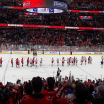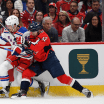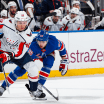April 26 vs. New York Rangers at Capital One Arena
Time: 7:00 p.m.
TV: TNT, MNMT
Radio: Capitals Radio 24/7
Game 3, First round Eastern Conference series, Rangers lead, 2-0
New York Rangers (55-23-4)
Washington Capitals (40-31-11)
Despite being down 0-2 in their best-of-seven opening round playoff set with the New York Rangers, the Caps return home for Friday’s critical Game 3 with some confidence. Their Game 2 performance in Tuesday’s 4-3 loss in Manhattan was much more on brand for the Capitals, and they’re confident and hopeful that they can muster a similar and better performance on Friday night to put themselves in the win column.
Friday’s Game 3 is the Caps’ first home playoff game this spring, and the team’s first in their own building in nearly two years, since May 13, 2022.
“I’m always saying it’s an exciting time for us, for our fans,” says Caps’ captain Alex Ovechkin. “We missed the playoffs last year, so it’s going to be a pretty cool atmosphere for sure.”
Washington returned home immediately after Tuesday’s loss, and it took a day off on Wednesday before reconvening for a Thursday morning practice at MedStar Capitals Iceplex. The Caps have been missing two top four defensemen for close to two weeks now, and injured blueliners Nick Jensen and Rasmus Sandin were again on the ice with their teammates at the Caps’ Thursday practice session. But again, both were clad in powder blue non-contact sweaters, as they’ve been for the last week or so.
“They’re just working their way back,” says Caps’ coach Spencer Carbery of the injured blueliners. “I can’t really give you any other update than that. Still in non-contact [sweaters], skated today. We’ll see how they are [Friday].”
The same is true for Sonny Milano, whose absence from Thursday’s practice was officially a “maintenance day.” Milano’s status for Friday’s Game 3 will also be reassessed on game day morning.
Before the series got underway last weekend, Carbery noted the importance of playing as much of the series at 5-on-5 as possible.
“Another one of the top priorities is to keep the series at 5-on-5 as much as we can,” Carbery said. “The penalty kill also for [the Rangers] is third in the League; the power play is third in the League. So it’s a point of emphasis. And we want to play hard; we want to physically impose our will. But we want to do it whistle to whistle.”
To Carbery’s point, the Caps have played hard, but each of the first two games has tilted too heavily toward special teams for Washington’s liking. Of the eight ongoing first-round playoff series, the Washington-New York set has featured the lowest amount of 5-on-5 play; it’s the only series averaging less than 45 minutes of 5-on-5 time per game.
There were some early jitters on the part of some of Washington’s burgeoning group of younger players; seven Caps have already made their Stanley Cup playoff debuts in this series. But they’ve settled in nicely now, and the Caps’ Game 3 focus is centered on limiting the mistakes that hampered them in New York, and in playing more of the game at 5-on-5.
“You've heard people say beforehand that every little play can make a big difference,” says Caps’ center Connor McMichael. “And just throughout these two games, that's already been on display for myself, personally. But I think we know we're in this series. I thought we outplayed them – to be honest – last game; we had a lot of good looks. At least at 5-on-5, I thought we were the better team.”
Washington has liked its game at 5-on-5, and it would prefer to play more minutes at full and even strength going forward in the series. As Carbery notes above, both New York special teams are elite. But the Rangers finished the season tied for 18th in 5-on-5 scoring and ranked 15th in 5-on-5 goals against. In facing the League’s Presidents’ Trophy-winning team, the Caps know they have little margin for mistake, and they also need to take full advantage of anything that might help swing the momentum of the series in their favor. That includes making the Rangers play as much of the game in conditions where they’re merely ordinary, as opposed to elite.
“I thought we were much better at recovering pucks,” says Carbery of the Caps’ Game 2 efforts at 5-on-5. “I thought we did a good job of being able to attack the net, and then get that puck recovery, and get another opportunity. We had way better sequences where we were able to create a little bit more movement in the offensive zone, where our [defensemen] started to get active, we skated on touch. Those produced a lot more sustained pressure, and then was able to set the next line up for a little bit of success as well.
“Everybody's fighting for [offensive] zone time, especially this time of year. The key is, can you sustain it, to [when] it becomes 20-30 seconds, to where their group is tired, they get a puck out, and they're just looking to change? And now you're coming quick, and you're coming right back on top of them. So now you've set up another shift of enabling the next group of forwards and [defensemen] to be able to play in the offensive zone.”
At their best, the Caps can be connected and cohesive in the offensive zone. When they’re feeling it, and when they’re predictable to one another, they can create some offensive zone movement, and that kind of organized chaos – along with some well-placed traffic – can lead to shots, rebounds, looks, and goals.
“We did a way better job last game of having [offensive] zone time, and making them work to strip pucks off us, and get out of the [defensive] zone,” says McMichael. “I know it was a power play goal, but you look at [Tom Wilson’s] goal, we had traffic right in front of them. He didn't even see it. That's what we want to do at 5-on-5, and he's for sure one of the best goalies in the League, so we want to make it tough on him, and almost make the net a little bit bigger; stand back door and make him think about the guys off the puck a little bit.”
The offensive zone time is critical for the Caps, because it keeps New York out of the Washington end of the ice, but it also gives the Caps the opportunity to exact a toll on the New York defense corps, to make them skate and labor in their own end, and to make a long-term investment in the series.
“I do think that it’s a different game in the playoffs,” says Caps’ left wing Max Pacioretty. “I mean that in the sense that you’re going to have to do a lot of things that don’t show up on the scoresheet, but they help your line or your team score goals, or to be a difference maker. So when it’s your turn to go to the net and take away the goalie’s eyes, that’s not only going to help the shooter, but it’s going to free up the second guy going to the net, and could free up that second opportunity, untouched.
“We’ve seen examples of that and have had success doing that. Really, that’s the only way to score goals, especially as the playoffs go on and the games get more and more important.”
Washington has been playing important games for a couple of months now; the importance of each successive contest seems to ratchet up another notch or two. But losing streaks are poison to playoff success. Four losses in a row is instant death, three straight defeats typically puts you on life support, and even the two consecutive setbacks the Caps are currently saddled with are highly uncomfortable to sit with at this time of year. The Caps know how crucial Game 3 is to them.
Scoring first, as always, would be welcome. McMichael unlocked that achievement for the Caps in Game 2, but before Washington could build on that slimmest of cushions, the Rangers answered back with the first of three special teams tallies in what became a 4-3 Game 2 victory.
“Get the first one,” says McMichael, “It would have been nice to get another one after the first one to just solidify our lead a little bit. We'll see how it goes in Game 3, but I think if we play like we did in Game 2, we’ve got a really good chance, especially at home.
“We're in this series. I don't think a series starts until you lose at home. So we're right in this thing, and we're ready.”



















